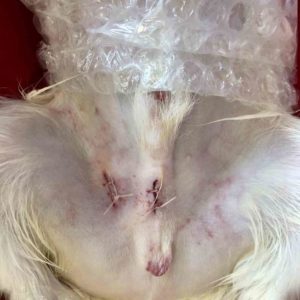Cryptorchidism In Dogs | This condition is considered to be genetic. The cost of cryptorchid surgery may add $150 to $300 in addition to the regular cost of a neuter in cats and dogs. When one of both of the testes do not descend properly, this can pose a range of problems. In addition, surviving female offspring may experience reproductive issues when bred, potentially affecting the viability of a breed or a line of a breed when cryptorchidism occurs in purebred dogs. Without surgical intervention, it is often impossible to distinguish cryptorchidism from monarchism or.
Diagnosis of cryptorchidism in dogs. Causes of cryptorchidism in dogs. My pug (two years old) has cryptorchidism and i am taking him on monday for exploratory abdominal surgery to remove them. How to treat cryptorchidism in dogs. The risk of developing testicular neoplasia is estimated to be at least ten times greater in dogs with cryptorchidism than in normal dogs.

The outstanding features of cryptorchidism in dogs, including the diagnosis, clinical symptoms and breeding policy, are discussed. Dogs with cryptorchidism typically display the same hormonally driven behaviors as dogs with descended testicles. Signs of cryptorchidism in dogs. Cryptorchidism in dogs including diagnosis and symptoms, pathogenesis, prevention, treatment, prognosis and more. The word is from the greek κρυπτός (kryptos), meaning hidden, and ὄρχις (orchis), meaning testicle. Cryptorchidism is often the cause of the disruption of the hormonal and reproductive function of testicles. Causes of cryptorchidism in dogs. First of all it means that the dog will not be able to be castrated normally to neuter them, and also, it provides a greatly heightened risk of the development of. In 3 cases, an increase in the size of the abdominal testes with the symptoms of hyperestrogenism and feminisation raised a suspicion of neoplastic changes (sct) taking place, which was confirmed by a histopathological examination. Cryptorchidism is a common clinical problem in dogs and cats. In addition, surviving female offspring may experience reproductive issues when bred, potentially affecting the viability of a breed or a line of a breed when cryptorchidism occurs in purebred dogs. Dogs with this condition are 10 times more likely to develop testicular cancer. Without surgical intervention, it is often impossible to distinguish cryptorchidism from monarchism or.
It is not possible for this. This condition is considered to be genetic. However, in some dogs it can take up to 4 months to appear. Cryptorchid dogs should never be bred. The outstanding features of cryptorchidism in dogs, including the diagnosis, clinical symptoms and breeding policy, are discussed.

My pug (two years old) has cryptorchidism and i am taking him on monday for exploratory abdominal surgery to remove them. Signs of cryptorchidism in dogs. The diagnosis is frequently made in the young healthy dog when he is presented to the veterinarian for routine castration. For dogs, the descent to the final scrotal position is expected to be complete by the time the puppy is two months old. The risk of developing testicular neoplasia is estimated to be at least ten times greater in dogs with cryptorchidism than in normal dogs. Female descendants of cryptorchid dogs may born dead or absorbed by their mothers before birth. Cryptorchidism is a common clinical problem in dogs and cats. It is not possible for this. Cryptorchidism is the absence of one or both testes from the scrotum. Causes of cryptorchidism in dogs. Perform a thorough physical examination.(1) carefully evaluate the scrotum, prescrotal area, inguinal canals, and abdominal cavity. First of all it means that the dog will not be able to be castrated normally to neuter them, and also, it provides a greatly heightened risk of the development of. In addition, surviving female offspring may experience reproductive issues when bred, potentially affecting the viability of a breed or a line of a breed when cryptorchidism occurs in purebred dogs.
The cost of cryptorchid surgery may add $150 to $300 in addition to the regular cost of a neuter in cats and dogs. The temperature inside the body is too high and sperm. This condition is considered to be genetic. It is not possible for this. Female descendants of cryptorchid dogs may born dead or absorbed by their mothers before birth.

The temperature inside the body is too high and sperm. The word is from the greek κρυπτός (kryptos), meaning hidden, and ὄρχις (orchis), meaning testicle. Without surgical intervention, it is often impossible to distinguish cryptorchidism from monarchism or. Perform a thorough physical examination.(1) carefully evaluate the scrotum, prescrotal area, inguinal canals, and abdominal cavity. First of all it means that the dog will not be able to be castrated normally to neuter them, and also, it provides a greatly heightened risk of the development of. Some researchers believe that dogs with cryptorchidism may have a higher incidence of other testicular diseases. It may occur later in some breeds, but rarely after six months. Cryptorchidism is a common clinical problem in dogs and cats. Cryptorchidism is often the cause of the disruption of the hormonal and reproductive function of testicles. Yates d, hayes g, heffernan m & beynon r (2003) incidence of cryptorchidism in dogs and cats. Descent to the final scrotal position should be completed by two months of age. Signs of cryptorchidism in dogs. Cryptorchidism is the absence of one or both testes from the scrotum.
Cryptorchidism is often the cause of the disruption of the hormonal and reproductive function of testicles cryptorchidism. Cryptorchid dogs should never be bred.
Cryptorchidism In Dogs: Signs of cryptorchidism in dogs.
Source: Cryptorchidism In Dogs
No comments:
Post a Comment